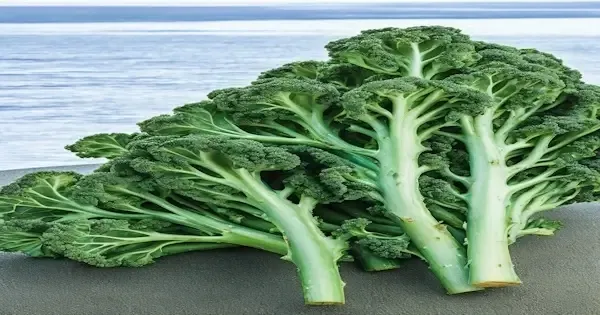Diet on Sea Kale:
Sea kale, scientifically known as Crambe maritima, is a remarkable vegetable that thrives in coastal regions. With its vibrant green leaves and unique flavor, sea kale has gained popularity among health-conscious individuals. Not only does it offer a delightful addition to your culinary adventures, but it also boasts numerous nutritional benefits.
 |
Sea Kale |
Table of Contents
Introduction
Sea kale, also known as sea colewort or crambe, is a leafy green vegetable native to coastal regions. This nutritious plant has been cherished for centuries due to its culinary versatility and health benefits. Its distinctive taste, reminiscent of a mild combination of cabbage and spinach, makes it an excellent addition to various dishes.
Sea kale is not only a flavorful ingredient but also a powerhouse of essential nutrients. Packed with vitamins, minerals, and antioxidants, it can enhance your well-being and support a healthy lifestyle. Let's explore the nutritional value of sea kale and delve into the many reasons why you should consider incorporating it into your diet.
Nutritional Value
Sea kale is a nutrient-dense vegetable that offers an array of vitamins and minerals. A 100-gram serving of sea kale provides approximately:
| Nutrient | Amount |
|---|---|
| Calcium | 150 mg |
| Potassium | 400 mg |
| Vitamin C | 45 mg |
| Vitamin K | 200 mcg |
| Folate | 90 mcg |
| Dietary Fiber | 3 g |
In addition to these nutrients, sea kale also contains trace amounts of iron, magnesium, and vitamin A. Its low calorie content makes it an ideal choice for those aiming to maintain a healthy weight or lose excess pounds.
Cooking Methods
Sea kale can be prepared in various ways, allowing you to explore its flavors and textures. Here are a few popular cooking methods:
1. Steaming:
Steaming sea kale preserves its nutrients while maintaining its crispness. Simply steam the leaves for a few minutes until they become tender but retain their vibrant green color. Season with a pinch of salt and enjoy as a side dish.
2. Sautéing:
Sautéing sea kale with garlic and olive oil brings out its natural sweetness. Heat a pan over medium heat, add minced garlic and olive oil, and sauté the sea kale until it wilts. Sprinkle with a squeeze of lemon juice for an extra burst of flavor.
3. Roasting:
Roasting sea kale gives it a delightful crispy texture. Toss the leaves with a drizzle of olive oil, salt, and pepper, then spread them on a baking sheet. Roast in a preheated oven at 400°F (200°C) for about 10-15 minutes until they turn golden and slightly charred.
Health Benefits
Sea kale offers numerous health benefits, making it a valuable addition to your diet:
1. Rich in Antioxidants:
Sea kale is abundant in antioxidants that protect your body against free radicals, which can cause oxidative stress and damage cells. These antioxidants help reduce the risk of chronic diseases, such as heart disease and certain types of cancer.
2. Supports Bone Health:
Thanks to its calcium and vitamin K content, sea kale contributes to maintaining strong and healthy bones. Adequate calcium intake is essential for bone mineral density, while vitamin K plays a crucial role in bone metabolism and the prevention of osteoporosis.
3. Boosts Immunity:
The high vitamin C content in sea kale strengthens your immune system, aiding in the prevention of common illnesses and infections. It supports the production of white blood cells and acts as an antioxidant to combat harmful pathogens.
4. Enhances Digestive Health:
Sea kale is a good source of dietary fiber, promoting a healthy digestive system. Fiber aids in regular bowel movements, prevents constipation, and supports the growth of beneficial gut bacteria.
Questions and Answers
Q: Can sea kale be eaten raw?
A: While sea kale can be consumed raw, it is more commonly cooked to enhance its flavor and texture. However, young and tender sea kale leaves can be enjoyed in salads or as a garnish.
Q: Is sea kale suitable for individuals on a low-sodium diet?
A: Yes, sea kale is a great choice for those on a low-sodium diet. It contains minimal sodium, making it an excellent alternative to high-sodium vegetables like canned beans or pickles.
Q: Can sea kale be frozen?
A: Yes, sea kale can be frozen for future use. Before freezing, blanch the leaves in boiling water for a few minutes, then transfer them to an ice bath. Once cooled, pat them dry and store in airtight containers or freezer bags.
Conclusion
Incorporating sea kale into your diet can offer a wide range of nutritional benefits. With its impressive array of vitamins, minerals, and antioxidants, sea kale supports bone health, enhances your immune system, and promotes overall well-being. Whether steamed, sautéed, or roasted, sea kale provides a delicious and nutrient-packed addition to your meals. Its unique flavor and versatility make it a delightful ingredient to experiment with in the kitchen.
Remember to explore the various cooking methods mentioned earlier to make the most of sea kale's flavors and textures. Whether you steam it, sauté it, or roast it, you'll find that sea kale adds a vibrant touch to your dishes.
In conclusion, sea kale is a nutritional powerhouse that offers a wide range of health benefits. From its rich antioxidant content to its support for bone health and immune function, incorporating sea kale into your diet can contribute to your overall well-being. So, why not explore this wonderful vegetable and discover the many ways it can enhance your meals and nourish your body?
Make sea kale a part of your culinary repertoire and savor the incredible taste and nutritional value it brings to the table. Embrace its vibrant green leaves and reap the rewards of a well-balanced diet enriched with this remarkable coastal treasure.


